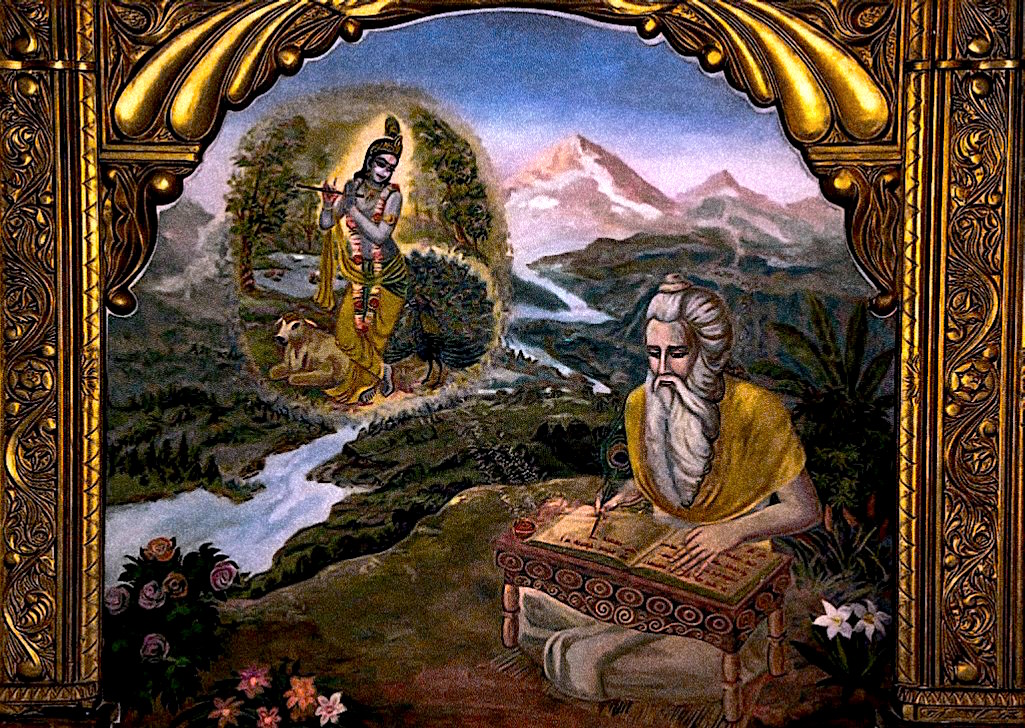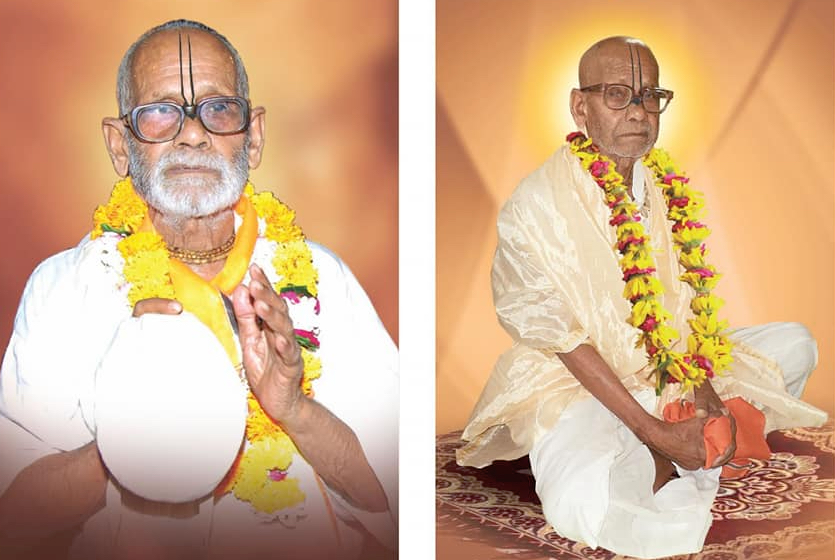Mahanidhi Madan Gopal Das
Srimad Bhagavatam is called the “king of all spiritual books” (Grantha Raja) for good reason. Within this tri-guna-free, immaculate and divine spiritual sastra, the amala purana, one will find all the sweet, majestic and beautiful truths about the sadhana and sadhya (daily practices and perfection) of Gaudiya Vaisnavism.
In his most merciful and wonderful sastra, Sri Caitanya Caritamrita, Sri Krishna Dasa Kaviraja summarizes all the teachings of Sri Caitanya Mahaprabhu and the six Goswamis of Vrindavana. Throughout the book he cites key Bhagavatam verses to prove these truths, which the Goswamis themselves also discuss in their works.
To highlight its importance for all devotees of Sri Caitanya Mahaprabhu and Radha-Govinda Yugala, the same Bhagavatam verse is quoted once, twice or even four times in the Sri Caitanya Caritamrta.
With the grace of Sri Advaita Prabhu, Sri Guru and the Vaisnavas, the “Beautiful Truths of Bhagavata” series will focus on these Bhagavatam verses that reveal the absolute truth about Sri Krishna, Sri Radha, Sri Guru, Vaisnavas, Bhakti Sadhana, Sri Harinama and Krishna Prema.
* THE BEAUTIFUL TRUTH OF THE VAISNAVAS
The first post in this series discussed Guru tattva. Now we will present the key Srimad Bhagavatam verses describing the identity of Krishna’s devotees, associating with them and serving these compassionate and tangible mercy forms of Bhagavan Sri Krishna.
All sincere sadhakas should learn and reflect upon these verses. Absorbing, understanding and implementing these truths will strengthen your faith, expand your joy, and double your enthusiasm to love, serve and respect all the humble servants of Sri Sri Radha and Krishna.
Devotees Live in Damodara’s Heart
sādhavo hṛdayaṁ mahyaṁ sādhūnāṁ hṛdayaṁ tv aham
mad-anyat te na jānanti nāhaṁ tebhyo manāg api
Sri Krishna says, “O Sage Durvasa! Saintly devotees are always in the core of My heart. And I am always in their hearts. They know nothing but Me, and I know nothing but them.” (Srimad Bhagavatam 9.4.68/Caitanya Caritamrita 1.1.62)
Krishna Devotees Are Walking Holy Places
bhavad-vidhā bhāgavatās tīrtha-bhūtāḥ svayaṁ vibho
tīrthī-kurvanti tīrthāni svāntaḥ-sthena gadābhṛtā
When Vidura returned from his tirtha-yatra, Maharaja Yudhisthira said, “O Vibho! Devotees like yourself are the embodiments of all holy places. Because you carry Bhagavan Sri Krishna within your heart, you turn all places into holy tirthas.” (Srimad Bhagavatam 1.13.10/Caitanya Caritamrita 1.1.63)
Six Ornaments of a Devotee
titikṣavaḥ kāruṇikāḥ suhṛdaḥ sarva-dehinām
ajāta-śatravaḥ śāntāḥ sādhavaḥ sādhu-bhūṣaṇāḥ
“Devotees are adorned with the six good qualities of being tolerant, merciful, friendly to all beings, without enemies, peaceful, and straightforward.” (Srimad Bhagavatam 3.25.21/Caitanya Caritamrita 2.22.81)
Serving Saints Gives Liberation
mahat-sevāṁ dvāram āhur vimuktes tamo-dvāraṁ yoṣitāṁ saṅgi-saṅgam
mahāntas te sama-cittāḥ praśāntā vimanyavaḥ suhṛdaḥ sādhavo ye
“Serving saintly devotees opens the door of liberation. Whereas, association with men connected with women opens the door to hellish life. The saintly are very peaceful, pride-less, kind to all and well-behaved.” (Srimad Bhagavatam 5.5. 2/Caitanya Caritamrita 2.22.82)
Sri Visvanatha Cakravartipada says sadhavah means “those who do not see fault in others.
Unique Rarity of Krishna Bhaktas
muktānām api siddhānāṁ nārāyaṇa-parāyaṇaḥ
sudurlabhaḥ praśāntātmā koṭiṣv api mahā-mune
“Among all the perfect ones, the blissful devotee of Narayana/Sri Krishna is very rare—one in a million.” (Srimad Bhagavatam 6.14.5/Caitanya Caritamrita 2.19.150)
Sri Krishna Saves His Devotees
sva-pāda-mūlam bhajataḥ priyasya tyaktānya-bhāvasya hariḥ pareśaḥ
vikarma yac cotpatitaṁ kathañcid dhunoti sarvaṁ hṛdi sanniviṣṭaḥ
“One who gives up all other engagements to surrender to the lotus feet of Sri Hari is very dear to Bhagavan. Indeed, if such a dedicated soul accidentally commits a sin, Antaryami Sri Krishna within one’s heart, immediately removes the sinful reaction.” (Srimad Bhagavatam 11.5.42/Caitanya Caritamrita 2.22.144)
Srila Prabhupada tika: Although a beloved child may accidentally commit an abominable activity, the loving father forgives the child, taking into consideration the actual good intentions of the child.
Although the devotee does not ask Sri Krishna to free him the future suffering from his sins, Sri Krishna, by His own sweet will, frees the devotee from the reactions to accidental fall downs.
This causeless mercy of Sri Krishna upon His devotee is His param- aisvaryam, or supreme opulence. Gradually the faithful devotee becomes pure and free from sins just by thinking of and serving Govinda’s lotus feet. Thus Krishna bhaktas are never actually defeated in life.
All Nama Chanters Are Great
aho bata śva-paco ’to garīyān yaj-jihvāgre vartate nāma tubhyam
tepus tapas te juhuvuḥ sasnur āryā brahmānūcur nāma gṛṇanti ye te
“O, how astonishing and worshipable are even dog-eaters if they chant Krishna nama! They have already performed all kinds of austerities and yajnas, cultivated good saintly virtues, bathed in all tirthas, and studied all Vedas”. (Srimad Bhagavatam 3.33.7/Caitanya Caritamrita 2.11.192)
Sripada Vallabhacarya tika (Sri Subodhini): Devahuti says, “By birth, class or conduct a chandala cannot compare with a Brahmin. However, the chandala is greater if he is chanting Krishna’s Divine Names. A complacent satisfied Brahmin performs actions for his own benefit. He may not chant Krishna’s names due to pride, ego or his status in society! In this way, he does not become a Krishna bhakta.
Sri Visvanatha Cakravartipada tika: The outcaste who chants even incompletely just one name of Bhagavan Sri Krishna is the best. He is a guru, and fully qualified to teach the mantra and the holy name to others i.e. diksa-guru. Amara-kosha says anūcura (line 2 of the verse above) means “a teacher, a person proficient in recitation of the Vedas with its angas.”
In prior lives the chandalas must have performed all types of yajnas and tapas, so now they no longer need to perform them nor will they do so in the future.
Srimad Bhagavatam Maha Purana ki jai! Hari Kathamrta ki jai! Jai Jai Sri Radhe!


